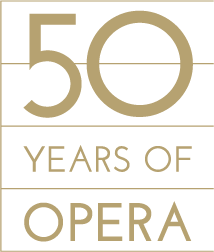This story is part of a series of 50 stories we are releasing to commemorate 50 years of opera in West Michigan. Browse more stories and follow our journey throughout the season.
People of color have a substantial tradition of building the opera in America, but that fact is often obscured. Contemporary artists are fighting hard to change that.

The art form of opera is about four hundred years old. It originated as an entertainment for the court of Mantua, the modern capital city of the province of Lombardy, Italy. Many Italian cities during that period were cosmopolitan; craftsmen, textile workers, and spice merchants from all over Europe and the Muslim world visited and lived in Mantua. And where there was trade during that era, there were slaves, usually taken from Eastern Europe, Greece, and Central Asia.
Given the mores of the time, people from foreign lands (not to mention slaves) were not generally allowed to perform for the court or the public. Unsurprisingly, opera was a largely Italian affair for its first few decades of life. Then, in 1627, the German opera tradition was born with Heinrich Schütz’s Dafne. Soon, traveling troupes would acquaint the Russians with the art form. France, Spain, and China would develop their own operatic traditions during the following centuries.
Opera evolved during the same time as the Enlightenment planted the first roots of a humanism that would ultimately destroy slavery, but the process took centuries. As a European artform, performed in countries where ethnic minorities were usually slaves, serfs, or scarcely tolerated, it is tragically predictable that people of many backgrounds were never afforded an opportunity to be part of opera’s evolution. Notable exceptions do exist, however.

Joseph Bologne, Chevalier de Saint-George, was a celebrated French violinist, composer, and champion fencer in the Age of Revolution. He was also the son of a planter and a slave. A prodigious musical talent, Saint-George composed, conducted, and played in the most prestigious musical institutions of the day. He nearly took the helm of the Paris Opera in 1776, but racism and fear of his rigorous methods caused divas among the company to protest his bid, and he withdrew. Not content to be a landmark figure in cultural circles, Saint-George went on to become a colonel in the French Revolution and lead Europe’s first regiment of black volunteers.
America was recovering from another war, in 1873, when the city of Washington got its first opera company. Only eight years after the end of the Civil War, The Colored American Opera debuted at Saint Augustine Roman Catholic Church. It was not unusual for black Americans to sing in church at the time, but an all-black choir singing sacred and classical music for the public was a rare thing indeed.
On February 3rd and 4th, 1873, The Colored American Opera Company staged its first and only production, The Doctor of Alcantara. One can imagine the skepticism of the local critical elite as they walked into the hall, especially considering the CAOC members’ lack of formal training. But newspapers of the day indicate the production soared past expectations. “We do not exaggerate when we say that this is one of the best choruses we have heard for some time,” said The Philadelphia Inquirer.
In 2008, the story of the visionary singers of The Colored American Opera Company was told in a contemporary work: Free to Sing: The story of the First African-American Opera Company. The production was conceived and performed by the Music Center at Strathmore, near Washington, DC, in Bethesda, Maryland. The production used narrative and musical elements, including opera, to explore the tale of former slaves and soldiers creating a musical institution amidst a hostile culture.
Of course, the story of American music in the twentieth century is largely the story of black music. Blues, jazz, funk, soul, gospel, and hip hop are the pillars on which much of our national musical identity is built. Today, some of the most visible and financially successful musicians in the world are black. But opera, and classical music generally, has been much slower to include people of color in its ranks. Still, we are seeing more librettists, composers, and singers of diverse backgrounds in the opera world than ever before.

Some luminaries have lit the way for contemporary artists of color: the ninety-one-year-old Leontyne Price became a star at the Metropolitan Opera in the late 1950s. Robert McFerrin, Bobby McFerrin’s father, was the first African-American man to sing at the Met, in 1953. Mezzo-soprano Shirley Verrett sang for the Met for thirty years, from 1961 onward. Jessye Norman dazzled audiences at La Scala, Stuttgart, and throughout Europe in the seventies, before moving her career stateside.
People of color have a substantial tradition of building the opera in America, but that fact is often obscured. Contemporary artists are fighting hard to change that.
Lawrence Brownlee, artistic adviser at Opera Philadelphia, is intent on creating work that is about the black experience in America. Brownlee commissioned Cycles of My Being, a work about a black man who dies while in police custody, to put his anxieties about race relations front and center. Composed by Tyshawn Sorey, with lyrics by Terrance Hayes, Cycles goes to places that will make many people uncomfortable. But Brownlee is cautiously optimistic about the contemporary opera scene, in regard to race. But he still finds hurdles, even if they have taken subtler forms. As he told The Guardian last month, “You can’t blind-cast with opera. No one has ever turned me down for a part and said ‘Because he’s black’ or even ‘Because he’s small and black!’ but there’s a code I’ve come to understand – ‘We have a different idea for the role’ is a common one.” He says that change is happening, however slowly, and that truly color-blind casting isn’t appropriate for the art, either—he quickly recuses himself from consideration for the title role of Verdi’s Otello, based on his vocal register.
Those interested in contemporary black contributions to opera—whether of the black history or European pastoral variety—can find a handful of New York companies working to increase visibility. The Harlem Opera Theater, Opera Ebony, and Opera Noire of New York are all creating and performing innovative work in the opera space and giving people of color opportunities to take center stage. By performing works about Malcolm X, Robert McFerrin, and the modern racial landscape, these companies are leading the charge in making opera an accessible art form for people who are looking for something other than Rigoletto. The efforts of contemporary African-American composers and performers are giving America a timeless gift: they are using American voices to tell quintessentially American stories.

OUR FOUNDERS HAD A BOLD PROPOSITION: to build a professional opera company that would put Grand Rapids on the map for a very discerning audience. 50 years later, we are humbled to be the modern bearers of classical standards and modern ingenuity. Learn more.
SUPPORT OUR NEXT 50 YEARS
As an integral part of our city’s artistic fabric, it’s our responsibility to see to its continual flourishing. Please consider donating to Opera Grand Rapids to ensure our artistic excellence for the next 50 years and beyond. You’ve already made us great. With your support, there’s no limits to the height our voices can reach together. Give today.

